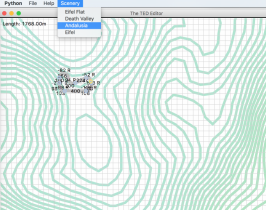- 1,233

- VS & 74 (France)
- GT-Alex74
Here's a track I made with 1.1.0, which was enough to get me where I wanted for that one. It's a mashup of corners from various real circuits.
Main straight 1km
Copse
Corkscrew - Rainey curve
Senna S - Curva do sol (mirrored)
Pouhon (mirrored) into 200R - Spoon (I'm in love with how that section flows)
Tsukuba last corner
Schumacher S (mirrored)
Porsche curves (mirrored)
Autopolis 85R
https://www.gran-turismo.com/fr/gt6/user/#!/friend/GT-Alex74/course/2574909/
------------------------------
A point to point track combining two pieces of road I like and drive quite often in real life (especially first part, lived right at the bottom of that moutain pass for several years, and before I had my licence, I'd ask friends to call me an hour before if they were planning to drive there so I could get at the top and wait for them to get nice pictures). The feeling in game is just right, I'm highly pleased.
https://www.gran-turismo.com/fr/gt6/user/#!/friend/GT-Alex74/course/2577719/
And a couple small videos of the real deal for reference :
-------------------------------
Finally, a completely fantasy track made with 1.1.1 to touch up some elevations and give a bit of texture to some of the corners. Feels a bit like an older NFS track in a way, fun but quite hard to master, especially with a understeer balanced car.
https://www.gran-turismo.com/fr/gt6/user/#!/friend/GT-Alex74/course/2579147/
Can't wait to play with the latest version
Main straight 1km
Copse
Corkscrew - Rainey curve
Senna S - Curva do sol (mirrored)
Pouhon (mirrored) into 200R - Spoon (I'm in love with how that section flows)
Tsukuba last corner
Schumacher S (mirrored)
Porsche curves (mirrored)
Autopolis 85R
https://www.gran-turismo.com/fr/gt6/user/#!/friend/GT-Alex74/course/2574909/
------------------------------
A point to point track combining two pieces of road I like and drive quite often in real life (especially first part, lived right at the bottom of that moutain pass for several years, and before I had my licence, I'd ask friends to call me an hour before if they were planning to drive there so I could get at the top and wait for them to get nice pictures). The feeling in game is just right, I'm highly pleased.
https://www.gran-turismo.com/fr/gt6/user/#!/friend/GT-Alex74/course/2577719/
And a couple small videos of the real deal for reference :
-------------------------------
Finally, a completely fantasy track made with 1.1.1 to touch up some elevations and give a bit of texture to some of the corners. Feels a bit like an older NFS track in a way, fun but quite hard to master, especially with a understeer balanced car.
https://www.gran-turismo.com/fr/gt6/user/#!/friend/GT-Alex74/course/2579147/
Can't wait to play with the latest version









 ). I've fixed that now and the new version 1.1.4b is available to download from
). I've fixed that now and the new version 1.1.4b is available to download from 